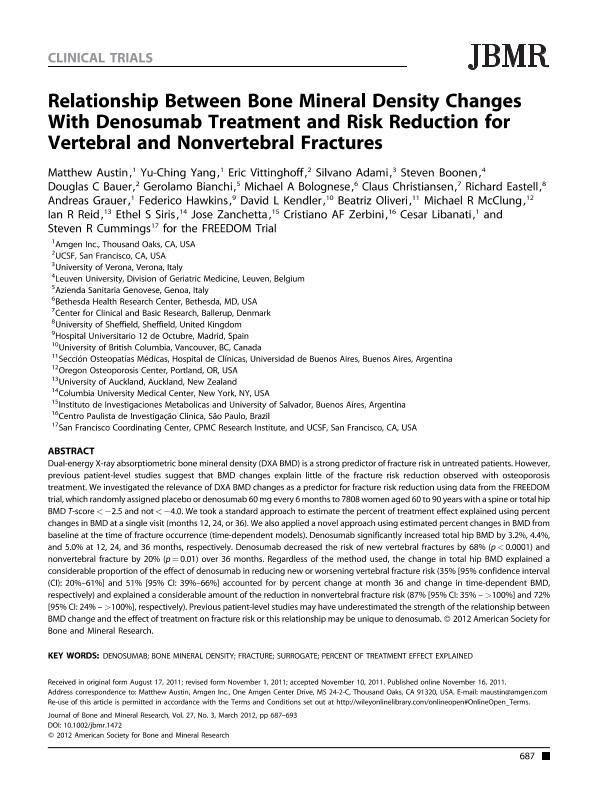Artículo
Relationship between bone mineral density changes with denosumab treatment and risk reduction for vertebral and nonvertebral fractures
Austin, Matthew; Yang, Yu Ching; Vittinghoff, Eric; Adami, Silvano; Boonen, Steven; Bauer, Douglas C; Bianchi, Gerolamo; Bolognese, Michael A.; Christiansen, Claus Bohn; Eastell, Richard; Grauer, Andreas; Hawkins, Federico; Kendler, David L.; Oliveri, María Beatriz ; McClung, Michael R.; Reid, Ian R.; Siris, Ethel S.; Zanchetta, Jose; Zerbini, Cristiano A.F.; Libanati, Cesar; Cummings, Steven R.
; McClung, Michael R.; Reid, Ian R.; Siris, Ethel S.; Zanchetta, Jose; Zerbini, Cristiano A.F.; Libanati, Cesar; Cummings, Steven R.
 ; McClung, Michael R.; Reid, Ian R.; Siris, Ethel S.; Zanchetta, Jose; Zerbini, Cristiano A.F.; Libanati, Cesar; Cummings, Steven R.
; McClung, Michael R.; Reid, Ian R.; Siris, Ethel S.; Zanchetta, Jose; Zerbini, Cristiano A.F.; Libanati, Cesar; Cummings, Steven R.
Fecha de publicación:
03/2012
Editorial:
American Society for Bone and Mineral Research
Revista:
Journal of Bone and Mineral Research
ISSN:
0884-0431
Idioma:
Inglés
Tipo de recurso:
Artículo publicado
Clasificación temática:
Resumen
Dual-energy X-ray absorptiometric bone mineral density (DXA BMD) is a strong predictor of fracture risk in untreated patients. However, previous patient-level studies suggest that BMD changes explain little of the fracture risk reduction observed with osteoporosis treatment. We investigated the relevance of DXA BMD changes as a predictor for fracture risk reduction using data from the FREEDOM trial, which randomly assigned placebo or denosumab 60 mg every 6 months to 7808 women aged 60 to 90 years with a spine or total hip BMD T-score < -2.5 and not < -4.0. We took a standard approach to estimate the percent of treatment effect explained using percent changes in BMD at a single visit (months 12, 24, or 36). We also applied a novel approach using estimated percent changes in BMD from baseline at the time of fracture occurrence (time-dependent models). Denosumab significantly increased total hip BMD by 3.2%, 4.4%, and 5.0% at 12, 24, and 36 months, respectively. Denosumab decreased the risk of new vertebral fractures by 68% (p < 0.0001) and nonvertebral fracture by 20% (p = 0.01) over 36 months. Regardless of the method used, the change in total hip BMD explained a considerable proportion of the effect of denosumab in reducing new or worsening vertebral fracture risk (35% [95% confidence interval (CI): 20%-61%] and 51% [95% CI: 39%-66%] accounted for by percent change at month 36 and change in time-dependent BMD, respectively) and explained a considerable amount of the reduction in nonvertebral fracture risk (87% [95% CI: 35% - >100%] and 72% [95% CI: 24% - >100%], respectively). Previous patient-level studies may have underestimated the strength of the relationship between BMD change and the effect of treatment on fracture risk or this relationship may be unique to denosumab. Copyright © 2012 American Society for Bone and Mineral Research.
Archivos asociados
Licencia
Identificadores
Colecciones
Articulos(INIGEM)
Articulos de INSTITUTO DE INMUNOLOGIA, GENETICA Y METABOLISMO
Articulos de INSTITUTO DE INMUNOLOGIA, GENETICA Y METABOLISMO
Citación
Austin, Matthew; Yang, Yu Ching; Vittinghoff, Eric; Adami, Silvano; Boonen, Steven; et al.; Relationship between bone mineral density changes with denosumab treatment and risk reduction for vertebral and nonvertebral fractures; American Society for Bone and Mineral Research; Journal of Bone and Mineral Research; 27; 3; 3-2012; 687-693
Compartir
Altmétricas



